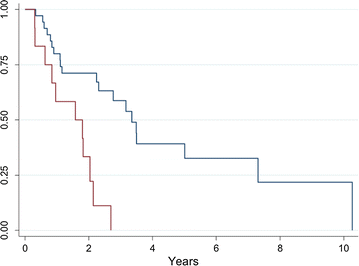Radiation induced angiosarcoma of the breast: outcomes from a retrospective case series
- PMID: 28794852
- PMCID: PMC5547463
- DOI: 10.1186/s13569-017-0081-7
Radiation induced angiosarcoma of the breast: outcomes from a retrospective case series
Abstract
Background: Radiation induced angiosarcoma (RIAS) of the breast is a rare and aggressive complication of radiotherapy. Due to the rarity of this disease, much of the evidence for its management is based on case reports or small retrospective series. We sought to describe the management and outcomes of RIAS in a large single-institution series.
Methods: All patients diagnosed with RIAS between January 2000 and January 2014 were identified from an institutional database.
Results: A total of 49 patients were identified. Median age at diagnosis was 72 years (range 51-93). Median time from completion of radiotherapy to diagnosis of RIAS was 7.5 years. Median tumour size at presentation was 5.0 cm (1.5-19.0). The majority of patients presented with localised disease (47, 95.9%). Of these, 35 (74.5%) were suitable for surgery and underwent surgery with curative intent. Twelve patients presented with localised irresectable disease. Of these, 7 received systemic chemotherapy, with a sufficient response to facilitate surgery in 3 patients. Following potentially curative surgery, 2-year local recurrence-free was 55.2%. Survival was significantly prolonged in patients presenting with resectable disease (2-year overall survival 71.1% vs 33.3%, p < 0.001). Tumour size >5 cm was prognostic of distant metastases-free survival and overall survival.
Conclusion: RIAS are rare, aggressive soft-tissue lesions with limited treatment options and high-rates of both local and systemic relapse.
Keywords: Angiosarcoma; Breast; Radiation.
Figures
References
LinkOut - more resources
Full Text Sources
Other Literature Sources



